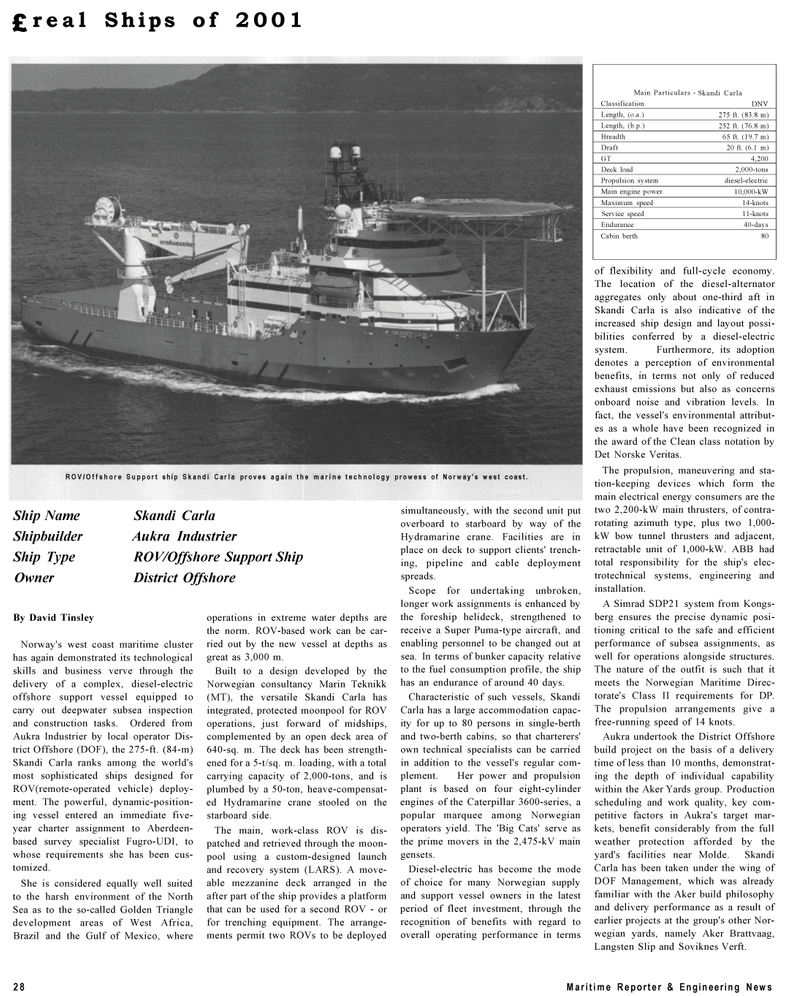
Page 28: of Maritime Reporter Magazine (December 2001)
Read this page in Pdf, Flash or Html5 edition of December 2001 Maritime Reporter Magazine
£ real Ships of 2001
Ship Name Skandi Carla
Shipbuilder Aukra Industrier
Ship Type ROV/Offshore Support Ship
Owner District Offshore
By David Tinsley
Norway's west coast maritime cluster has again demonstrated its technological skills and business verve through the delivery of a complex, diesel-electric offshore support vessel equipped to carry out deepwater subsea inspection and construction tasks. Ordered from
Aukra Industrier by local operator Dis- trict Offshore (DOF), the 275-ft. (84-m)
Skandi Carla ranks among the world's most sophisticated ships designed for
ROV(remote-operated vehicle) deploy- ment. The powerful, dynamic-position- ing vessel entered an immediate five- year charter assignment to Aberdeen- based survey specialist Fugro-UDI, to whose requirements she has been cus- tomized.
She is considered equally well suited to the harsh environment of the North
Sea as to the so-called Golden Triangle development areas of West Africa,
Brazil and the Gulf of Mexico, where operations in extreme water depths are the norm. ROV-based work can be car- ried out by the new vessel at depths as great as 3,000 m.
Built to a design developed by the
Norwegian consultancy Marin Teknikk (MT), the versatile Skandi Carla has integrated, protected moonpool for ROV operations, just forward of midships, complemented by an open deck area of 640-sq. m. The deck has been strength- ened for a 5-t/sq. m. loading, with a total carrying capacity of 2,000-tons, and is plumbed by a 50-ton, heave-compensat- ed Hydramarine crane stooled on the starboard side.
The main, work-class ROV is dis- patched and retrieved through the moon- pool using a custom-designed launch and recovery system (LARS). A move- able mezzanine deck arranged in the after part of the ship provides a platform that can be used for a second ROV - or for trenching equipment. The arrange- ments permit two ROVs to be deployed simultaneously, with the second unit put overboard to starboard by way of the
Hydramarine crane. Facilities are in place on deck to support clients' trench- ing, pipeline and cable deployment spreads.
Scope for undertaking unbroken, longer work assignments is enhanced by the foreship helideck, strengthened to receive a Super Puma-type aircraft, and enabling personnel to be changed out at sea. In terms of bunker capacity relative to the fuel consumption profile, the ship has an endurance of around 40 days.
Characteristic of such vessels, Skandi
Carla has a large accommodation capac- ity for up to 80 persons in single-berth and two-berth cabins, so that charterers' own technical specialists can be carried in addition to the vessel's regular com- plement. Her power and propulsion plant is based on four eight-cylinder engines of the Caterpillar 3600-series, a popular marquee among Norwegian operators yield. The 'Big Cats' serve as the prime movers in the 2,475-kV main gensets.
Diesel-electric has become the mode of choice for many Norwegian supply and support vessel owners in the latest period of fleet investment, through the recognition of benefits with regard to overall operating performance in terms
Main Particulars - Skandi Carla
Classification DNV
Length, (o.a.) 275 ft. (83.8 m)
Length, (b.p.) 252 ft. (76.8 m)
Breadth 65 ft. (19.7 m)
Draft 20 ft. (6.1 m)
GT 4,200
Deck load 2,000-tons
Propulsion system diesel-electric
Main engine power 10,000-kW
Maximum speed 14-knots
Service speed 11-knots
Endurance 40-days
Cabin berth 80 of flexibility and full-cycle economy.
The location of the diesel-alternator aggregates only about one-third aft in
Skandi Carla is also indicative of the increased ship design and layout possi- bilities conferred by a diesel-electric system. Furthermore, its adoption denotes a perception of environmental benefits, in terms not only of reduced exhaust emissions but also as concerns onboard noise and vibration levels. In fact, the vessel's environmental attribut- es as a whole have been recognized in the award of the Clean class notation by
Det Norske Veritas.
The propulsion, maneuvering and sta- tion-keeping devices which form the main electrical energy consumers are the two 2,200-kW main thrusters, of contra- rotating azimuth type, plus two 1,000- kW bow tunnel thrusters and adjacent, retractable unit of 1,000-kW. ABB had total responsibility for the ship's elec- trotechnical systems, engineering and installation.
A Simrad SDP21 system from Kongs- berg ensures the precise dynamic posi- tioning critical to the safe and efficient performance of subsea assignments, as well for operations alongside structures.
The nature of the outfit is such that it meets the Norwegian Maritime Direc- torate's Class II requirements for DP.
The propulsion arrangements give a free-running speed of 14 knots.
Aukra undertook the District Offshore build project on the basis of a delivery time of less than 10 months, demonstrat- ing the depth of individual capability within the Aker Yards group. Production scheduling and work quality, key com- petitive factors in Aukra's target mar- kets, benefit considerably from the full weather protection afforded by the yard's facilities near Molde. Skandi
Carla has been taken under the wing of
DOF Management, which was already familiar with the Aker build philosophy and delivery performance as a result of earlier projects at the group's other Nor- wegian yards, namely Aker Brattvaag,
Langsten Slip and Soviknes Verft.
ROV/Offshore Support ship Skandi Carla proves again the marine technology prowess of Norway's west coast. 28 Maritime Reporter & Engineering News

 27
27

 29
29
